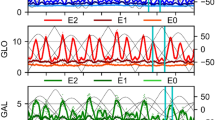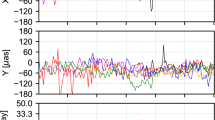Abstract
Significant differences in time series of geodynamic parameters determined with different Global Navigation Satellite Systems (GNSS) exist and are only partially explained. We study whether the different number of orbital planes within a particular GNSS contributes to the observed differences by analyzing time series of geocenter coordinates (GCCs) and pole coordinates estimated from several real and virtual GNSS constellations: GPS, GLONASS, a combined GPS/GLONASS constellation, and two virtual GPS sub-systems, which are obtained by splitting up the original GPS constellation into two groups of three orbital planes each. The computed constellation-specific GCCs and pole coordinates are analyzed for systematic differences, and their spectral behavior and formal errors are inspected. We show that the number of orbital planes barely influences the geocenter estimates. GLONASS’ larger inclination and formal errors of the orbits seem to be the main reason for the initially observed differences. A smaller number of orbital planes may lead, however, to degradations in the estimates of the pole coordinates. A clear signal at three cycles per year is visible in the spectra of the differences between our estimates of the pole coordinates and the corresponding IERS 08 C04 values. Combinations of two 3-plane systems, even with similar ascending nodes, reduce this signal. The understanding of the relation between the satellite constellations and the resulting geodynamic parameters is important, because the GNSS currently under development, such as the European Galileo and the medium Earth orbit constellation of the Chinese BeiDou system, also consist of only three orbital planes.












Similar content being viewed by others
Notes
Errors with the period of the revolution of the Sun w.r.t. an orbital plane (351.5 days for GPS and 353.2 days for GLONASS, Meindl 2011), and harmonics thereof.
References
Altamimi Z, Collilieux X, Métivier L (2011) ITRF2008: an improved solution of the international terrestrial reference frame. J Geod 85(8):457–473. doi:10.1007/s00190-011-0444-4
Arnold D, Meindl M, Beutler G, Dach R, Schaer S, Lutz S, Prange L, Sośnica K, Mervart L, Jäggi A (2015) CODE’s new solar radiation pressure model for GNSS orbit determination. J Geod 89(8):775–791. doi:10.1007/s00190-015-0814-4
Beutler G, Brockmann E, Gurtner W, Hugentobler U, Mervart L, Rothacher M, Verdun A (1994) Extended orbit modeling techniques at the CODE processing center of the international GPS service for geodynamics (IGS): theory and initial results. Manuscr Geod 19:367–384
Beutler G, Rothacher M, Schaer S, Springer TA, Kouba J, Neilan RE (1999) The international GPS service (IGS): an interdisciplinary service in support of Earth sciences. Adv Space Res 23(4):631–653
Bizouard C, Gambis D (2009) The combined solution C04 for Earth orientation parameters consistent with international terrestrial reference frame 2005. Int Assoc Geod Symp. doi:10.1007/978-3-642-00860-3_41
Blewitt G (1997) Self-consistency in reference frames, geocenter definition, and surface loading of the solid Earth. J Geophys Res 108(B2):2156–2202. doi:10.1029/2002JB002082
Dach R, Brockmann E, Schaer S, Beutler G, Meindl M, Prange L, Bock H, Jäggi A, Ostini L (2009) GNSS processing at CODE: status report. J Geod 83(3):353–365. doi:10.1007/s00190-008-0281-2
Dach R, Schaer S, Lutz S, Meindl M, Bock H, Orliac E, Prange L, Thaller D, Mervart L, Jäggi A, Beutler G, Brockmann E, Ineichen D, Wiget A, Weber G, Habrich H, Ihde J, Steigenberger P, Hugentobler U (2013) Center for orbit determination in Europe (CODE). In: Dach R, Jean Y (eds) International GNSS service: technical report 2013 (AIUB). IGS Central Bureau, Pasadena, pp 21–34
Dach R, Lutz S, Walser P, Fridez P (eds) (2015) The Bernese GPS software version 5.2. user manual, Astronomical Institute, University of Bern, Bern Open Publishing. ISBN 978-3-906813-05-9. doi:10.7892/boris.72297
Dick WR, Thaller D (eds) (2014) IERS annual report 2012. International Earth Rotation and Reference Systems Service. Central Bureau, Bundesamt für Kartographie und Geodäsie, Richard-Strauss-Allee-11, 60598 Frankfurt am Main, Germany, ISBN 978-3-86482-058-8
Dong D, Dickey JO, Chao Y, Cheng MK (1997) Geocenter variations caused by atmosphere, ocean and surface ground water. Geophys Res Lett 24(15):1867–1870. doi:10.1029/97GL01849
Dong D, Dickey JO, Chao Y, Cheng MK (1999) Geocenter variations caused by mass redistribution of surface geophysical processes. IERS Tech Note 25:47–54
Dow JM, Neilan RE, Rizos C (2009) The international GNSS service in a changing landscape of global navigation satellite systems. J Geod 83(3–4):191–198. doi:10.1007/s00190-008-0300-3
Gambis D (2004) Monitoring earth orientation using space-geodetic techniques: state-of-the-art and prospective. J Geod 78(4–5):295–303. doi:10.1007/s00190-004-0394-1
Griffith J, Ray JR (2012) Sub-daily alias and draconitic errors in the IGS orbits. GPS Solut 17:413. doi:10.1007/s10291-012-0289-1
Jäggi A, Hugentobler U, Beutler G (2006) Pseudo-stochastic orbit modeling techniques for low-Earth orbiters. J Geod 80(1):47–60. doi:10.1007/s00190-006-0029-9
Jäggi A, Weigelt M, Flechtner F, Güntner A, Mayer-Gürr T, Martinis S, Bruinsma S, Flury J, Bourgogne S (2015) European gravity service for improved emergency management—a new Horizon 2020 project to serve the international community and improve the accessibility to gravity field products. EGU General Assembly 2015, Vienna, Austria, 12–17 April 2015
Meindl M (2011) Combined analysis of observations from different global navigation satellite systems. Geodätisch-geophysikalische Arbeiten in der Schweiz, vol 83, Eidg. Technische Hochschule Zürich, Switzerland
Meindl M, Beutler G, Thaller D, Dach R, Jäggi A (2013) Geocenter coordinates estimated from GNSS data as viewed by perturbation theory. Adv Space Res 51(7):1047–1064. doi:10.1016/j.asr.2012.10.026
Press HW, Teukolsky SA, Vetterling WT, Flannery BP (2007) Numerical recipes: the art of scientific computing, 3rd edn. Cambridge University Press, Cambridge
Ray J, Altamimi Z, Collilieux X, van Dam T (2008) Anomalous harmonics in the spectra of GPS position estimates. GPS Solut 12(1):55–64. doi:10.1007/s10291-007-0067-7
Ray J, Griffiths J, Collilieux X, Rebischung P (2013) Subseasonal GNSS positioning errors. Geophys Res Lett 40(22):5854–5860. doi:10.1002/2013GL058160
Rebischung P, Altamimi Z, Springer T (2014) A collinearity diagnosis of the GNSS geocenter determination. J Geod 88:65–85. doi:10.1007/s00190-013-0669-5
Rodríguez-Solano CJ (2013) Impact of non-conservative force modeling on GNSS satellite orbits and global solutions. Ph.D. thesis, Technical University of Munich
Rodríguez-Solano CJ, Hugentobler U, Steigenberger P, Blossfeld M, Fritsche M (2014b) Reducing the draconitic errors in GNSS geodetic products. J Geod 88:559–574. doi:10.1007/s00190-014-0704-1
Sušnik A, Dach R, Villiger A, Maier A, Arnold D, Schaer S, Jäggi A (2016) CODE reprocessing product series. Published by Astronomical Institute, University of Bern. doi:10.7892/boris.80011
Wu X, Ray J, van Dam T (2012) Geocenter motion and its geodetic and geophysical implications. J Geodyn 58:44–61. doi:10.1016/j.jog.2012.01.00
Acknowledgements
The study was funded by the Swiss National Science Foundation in the frame of the Project “Advanced Satellite Orbit Modelling for GPS, GLONASS and Galileo” (200021_153429).
Author information
Authors and Affiliations
Corresponding author
Rights and permissions
About this article
Cite this article
Scaramuzza, S., Dach, R., Beutler, G. et al. Dependency of geodynamic parameters on the GNSS constellation. J Geod 92, 93–104 (2018). https://doi.org/10.1007/s00190-017-1047-5
Received:
Accepted:
Published:
Issue Date:
DOI: https://doi.org/10.1007/s00190-017-1047-5




